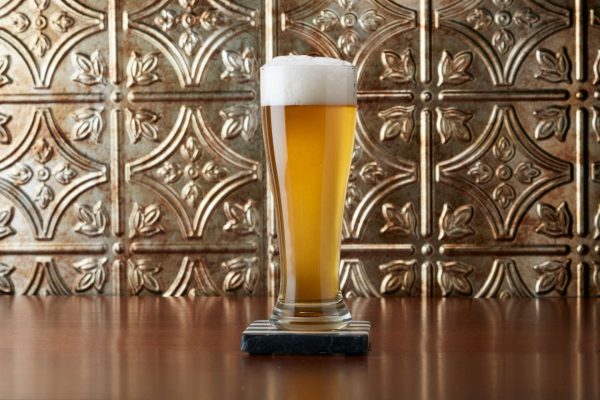
American porters have a stronger character than modern English porters (which is true for most American adaptations of traditional English styles). The challenge in making this style is to not have overly burnt flavors dominate, and not have the hops clash with the dark malts.
This version from Gordon Strong (featured in Modern Homebrew Recipes) uses roasted barley instead of black malt, and the hopping includes some orange and apricot flavors.
Sensory Description: Balanced roast with a bready base malt, slightly fruity fermentation character, and earthy hops. Moderately strong with a dry finish, malty and roast aftertaste, and balanced bitterness.
Formulation Notes: Fairly straightforward composition, featuring mostly English ingredients. The base malt and yeast are more neutral than an English version, which lets the specialty malts and hops be prominent. The hop flavor is higher on this version, with the first wort hops providing a woody, earthy note, while the later hops give more apricot and orange notes( which I think plays well with the chocolate and light coffee character). Strength and body are on the higher side. The dry hopping is optional, but I fresh hop character as an extra aroma dimension.
American porters have a stronger character than modern English porters (which is true for most American adaptations of traditional English styles). The challenge in making this style is to not have overly burnt flavors dominate, and not have the hops clash with the dark malts.
This version from Gordon Strong (featured in Modern Homebrew Recipes) uses roasted barley instead of black malt, and the hopping includes some orange and apricot flavors.
Sensory Description: Balanced roast with a bready base malt, slightly fruity fermentation character, and earthy hops. Moderately strong with a dry finish, malty and roast aftertaste, and balanced bitterness.
Formulation Notes: Fairly straightforward composition, featuring mostly English ingredients. The base malt and yeast are more neutral than an English version, which lets the specialty malts and hops be prominent. The hop flavor is higher on this version, with the first wort hops providing a woody, earthy note, while the later hops give more apricot and orange notes( which I think plays well with the chocolate and light coffee character). Strength and body are on the higher side. The dry hopping is optional, but I fresh hop character as an extra aroma dimension.
Ingredients:
- 13 lb (5.9 kg) US two-row – Mash
- 1 lb (454 g) UK Crystal 77 (Crisp) – Vorlauf
- 12 oz (340 g) UK Chocolate malt (Fawcett) – Vorlauf
- 6 oz (170 g) UK Roasted Barley – Vorlauf
- 2 oz (57 g) UK Fuggles 4.5% whole – FWH
- 0.75 oz (21 g) US Amarillo 8.6% whole @ 10 min
- 1 oz (28 g) Styrian Goldings 4.5% whole @ 5 min
- 1 oz (28 g) Styrian Goldings 4.5% whole dry hop
- White Labs WLP001 California ale yeast
- See directions for water treatment
Specifications:
Yield: 6.5 gallons (25 L)
Original Gravity: 1.060
Final Gravity: 1.014
ABV: 6.1%
IBU: 34
SRM: 36
Efficiency: 75%
Directions:
Water treatment: RO water treated with ¼ tsp 10% phosphoric acid per 5 gallons. 1 tsp CaCl2 in mash
Mash technique: Infusion, mashout, dark grains added at vorlauf
Mash rests: 154°F (68°C) 60 minutes, 170°F (77°C) 15 minutes
Kettle volume: 8 gallons (30 L)
Boil length: 75 minutes
Final volume: 6.5 gallons (25 L)
Fermentation temp: 64°F (18°C)
Variations: I also like using noble hops as the late finishing hops instead of the Styrians; I sometimes use Tettnanger, Halltertauer, or some of the US versions such as Vanguard or Santiam. If you really want to stand out as an American style, you can also use classic hops like Cascade and Centennial late. I normally use Cascade at knockout instead of the 5 minute addition and dry hop with Centennial. With fairly simple grist, this beer is also a good baseline for matching other beer flavors to source ingredients. Look for the deep caramel, chocolate, and coffee flavors and adjust the quantities based on what you prefer. I would adjust each of those specialty grains no more than 50% up or down as you experiment. I think this beer is also good with a lower bitterness level (in the mid 20s). I tend to mash a couple degrees lower when making aversion with lower bitterness (like 151°F/66°C). I’ve also made a more session strength version of this, reducing everything proportionally to be a 4% ABV beer and omitting the dry hopping altogether. A stronger 7% version is also good; I sometimes make that version to age.




Share Post